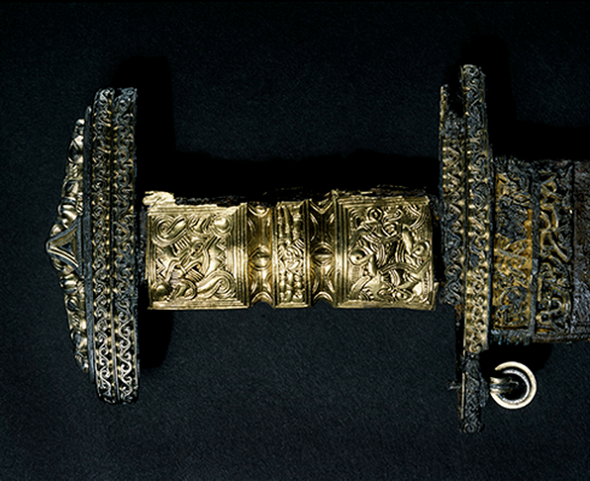You probably wouldn’t consider 6th century Scandinavia a hotbed of anything, much less technological and artistic innovation, but that’s precisely what was happening in that region of the world as a result of increased migration in an era that’s actually called “the Migration Period.” From around 400 to 550 CE (Common Era), the northern migration of Germanic tribes, following earlier encroachment by the Romans, brought a great deal of change to Scandinavia–now Denmark, Norway, and Sweden–a region that was predominantly tribal and populated with small farms and settlements. This is the epoch that gave birth to the Vikings and it began with an influx of ideas from the south.
One modern-day Norwegian paid homage to that long-ago period of awakening in his home country by replicating an artifact from that era of burgeoning technology and artistic mastery: Teacher, game developer, and 3D design- and printing enthusiast, Nils Anderssen used his expertise to produce a stunningly accurate reproduction of a 6th-century, double-edged, iron sword with a bronze hilt, which was originally crafted in Snartemo in Southern Norway. Anderssen used the cutting-edge technology of today to recreate a symbol of his country’s ancient, expert craftsmanship.
It has certainly been possible before 3D printing to undertake a project like Anderssen’s, but it has been more expensive and far more time-consuming. Also, Anderssen, who has many talents, is not a professional goldsmith, so he was willingly heading into uncharted territory when he began his Snartemo Sword project. What he did possess was an enthusiasm for history and historical artifacts and, of course, a maker’s curiosity and ingenuity, so he began his project, spending a couple of years figuring out how to go about using 3D printing to create a believable replica.
Eventually, Anderssen uploaded the results of his ongoing project on his website, which prompted the National Museum of Art in Oslo, Norway to approach him about creating a replica of the sword as a companion display to the real sword (which, as we understand it, is part of the permanent collection of the Museum of Cultural History in Oslo). The museum insisted, quite reasonably, that the copy should resemble the original as closely as possible. Visitors would be able to handle the replica, so it needed to feel like the original sword as well.
Equipped with photos and measurements of the sword, Anderssen used 3D Studio Max to create his 3D design. “In Studio Max,” he explained, “I have good control over the thickness and size of the patterns and therefore avoided problems in printing.” The sword’s sharp edges were easily modeled in 3D Studio Max. His secret was to use “almost exclusively…the basic features of the polygon modeling tools…”
Without the capacity to 3D print in bronze himself, Anderssen needed to find a 3D printing service to help him undertake this major part of the sword project. He did his research and opted to enlist i.materialize, whom, he found, could print larger sizes than most other companies. Not unlike the original process of crafting the sword, Anderssen’s replica was created in parts. After he received the 3D-printed bronze pieces from i.materialize, he smoothed them and then had them gilded. He did make one important change: With his design, the hilt was hollow and later filled with wood to make the finished piece more stable and to facilitate easier assembly.
It isn’t clear how and where the blade was produced, but the various pieces of the sword were assembled by Anderssen and the results were spectacular. He had the pleasure after completing the project of seeing his replica placed next to the original sword, by far the greatest test of his success. As the photo emphasizes, the similarities between the reproduction and the original really are remarkable. What a brilliant means of both preserving history without compromising the physical state of an ancient artifact and allowing those of us who want to appreciate such objects to do so in a more interactive way! We hope that this becomes a trend with museums and archives; 3D printing certainly makes it plausible and far more budget-friendly.
Let’s hear your thoughts on Anderssen’s work in the 3D Printed Replica Sword forum thread on 3DPB.com.
Subscribe to Our Email Newsletter
Stay up-to-date on all the latest news from the 3D printing industry and receive information and offers from third party vendors.
You May Also Like
3D Printing Unpeeled: New Arkema Material for HP, Saddle and Macro MEMS
A new Arkema material for MJF is said to reduce costs per part by up to 25% and have an 85% reusability ratio. HP 3D HR PA 12 S has been...
3D Printing News Briefs, January 20, 2024: FDM, LPBF, Underwater 3D Printer, Racing, & More
We’re starting off with a process certification in today’s 3D Printing News Briefs, and then moving on to research about solute trapping, laser powder bed fusion, and then moving on...
3D Printing Webinar and Event Roundup: December 3, 2023
We’ve got plenty of events and webinars coming up for you this week! Quickparts is having a Manufacturing Roadshow, America Makes is holding a Member Town Hall, Stratafest makes two...
Formnext 2023 Day Three: Slam Dunk
I’m high—high on trade show. I’ve met numerous new faces and reconnected with old friends, creating an absolutely wonderful atmosphere. The excitement is palpable over several emerging developments. The high...



































